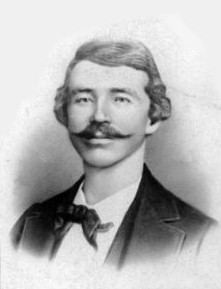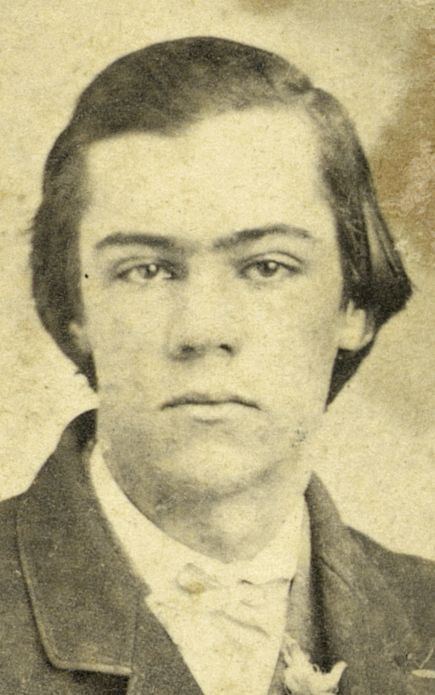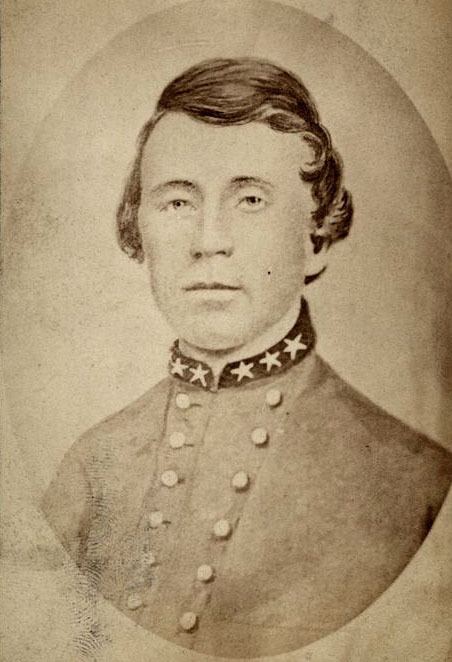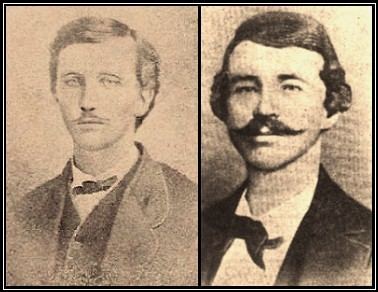Years of service 1861–1865 Rank Captain | Name William Quantrill | |
 | ||
Born July 31, 1837Canal Dover (now Dover), Ohio ( 1837-07-31 ) Service/branch Confederate States ArmyGuerrilla Battles/wars American Civil WarLawrence, Kansas Similar People Jesse James, James G Blunt, John Brown | ||
Katie armitage on william quantrill
William Clarke Quantrill (July 31, 1837 – June 6, 1865) was a Confederate leader during the American Civil War.
Contents
- Katie armitage on william quantrill
- William quantrill
- Early life
- Guerrilla leader
- Lawrence Massacre
- Last years
- Burial
- Claim of post 1865 survival
- Marriage
- Reputation and legacy
- Comics
- Film
- Literature
- Plays
- Television
- Historiography
- References

After a knockabout youth, he joined a group of bandits who roamed Missouri and Kansas, kidnapping escaped slaves in exchange for reward money. This apparently confirmed his pro-slavery views, and his group became Confederate 'bushwhackers', feared for their terror tactics, which used effective Native American field skills. They included Jesse James and his brother. In August 1863, the bandits murdered nearly 200 civilians in Lawrence, Kansas, a stronghold of anti-slavery sentiment. In May 1865, Quantrill was mortally wounded by Union troops in Western Kentucky, in one of the last engagements of the Civil War.

William quantrill
Early life
Quantrill was the oldest of twelve children, four of whom died in infancy. He was born at Canal Dover (now just Dover), Ohio, on July 31, 1837. His father was Thomas Henry Quantrill, formerly of Hagerstown, Maryland. His mother, Caroline Cornelia Clark, was a native of Chambersburg, Pennsylvania. They were married on October 11, 1836 and moved to Canal Dover the following December.

Quantrill was well-educated and followed in his father's footsteps, becoming a schoolteacher at the age of sixteen. In 1854, his abusive father died of tuberculosis, leaving the family with a huge financial debt. Quantrill's mother had to turn her home into a boarding house in order to survive. Quantrill helped support the family by working as a schoolteacher but left home a year later and headed to Mendota, Illinois. Here, Quantrill took up a job in the lumberyards, unloading timber from rail cars.
One night while working the late shift, he shot a man dead. Authorities briefly arrested Quantrill, who claimed self-defense. Since there were no eyewitnesses and the victim was a stranger who knew no one in town, William was set free. But police strongly urged him to leave Mendota. Quantrill continued his career as a teacher, moving to Fort Wayne, Indiana in February 1856. And although the district was impressed with Quantrill's teaching abilities, the wages remained meager. Quantrill journeyed back home to Canal Dover that fall, with no more money in his pockets than when he had left.
Quantrill spent the winter in his family's dumpy shack in the impoverished town, growing restless. It was around this time that many Ohioans began to migrate to Kansas Territory in search of cheap land and opportunity. This included Henry Torrey and Harmon Beeson, two local men hoping to build a large farm for their families out west. Although they didn't trust the 19-year-old William, Bill's mother's pleadings persuaded them to let her son accompany them to Kansas in an effort to get him to turn his life around.
The party of three departed in late February 1857. Torrey and Beeson agreed to pay for Quantrill's land in exchange for a couple of months' worth of work. They settled at Marais des Cygnes, but things did not go as well as planned. After about two months, Quantrill began to slack off when it came to working the land, and he spent most days wandering aimlessly about the wilderness with a rifle. A dispute arose over the claim, and he went to court with Torrey and Beeson. The court awarded the men what was owed to them, but Quantrill only paid half of what the court had mandated. His relationship with Beeson was never the same, but he remained friends with Torrey.
Shortly afterwards, Quantrill accompanied a large group of hometown friends in their quest to start a settlement on Tuscarora Lake. But soon neighbors began to notice Bill stealing goods out of other people's cabins, so they banished him from the community in January 1858.
He signed on as a teamster with the U.S. Army expedition heading to Salt Lake City, Utah in the spring of 1858. Little is known of Quantrill's journey out west, except that he excelled at the game of poker. He racked up piles of winnings by playing the game against his comrades at Fort Bridger but flushed it all on one hand the next day, leaving him dead broke.
Quantrill then joined a group of Missouri ruffians and became somewhat of a drifter. The group helped protect Missouri farmers from the Jayhawkers for pay and slept wherever they could find lodging. Quantrill traveled back to Utah and then to Colorado, but returned in less than a year to Lawrence, Kansas, in 1859. It was at this time that his political views started to take shape, and his attitude towards the slavery issue began to form.
Before 1860, Quantrill's political view appeared to support the anti-slavery side. He wrote to his good friend W.W. Scott in January 1858 that the Lecompton Constitution was a "swindle" and that James H. Lane, a Northern sympathizer, was "as good a man as we have here." He also called the Democrats "the worst men we have for they are all rascals, for no one can be a democrat here without being one."
One year later, in 1859, he was back in Lawrence, Kansas where he taught school until it closed in 1860. He then took up with brigands and turned to cattle rustling and anything else that could earn him a dollar. He also learned the profitability of capturing runaway slaves and devised plans to use free black men as bait for runaway slaves, whom he subsequently captured and returned to their masters in exchange for reward money.
His new lifestyle may have been the reason for his change of political views. In February 1860, Quantrill wrote a letter to his mother expressing his views on the anti-slavery supporters. He told her the pro-slavery movement was right and that he now detested Jim Lane. He said that the hanging of John Brown had been too good for him and that, "the devil has got unlimited sway over this territory, and will hold it until we have a better set of man and society generally."
Guerrilla leader
In 1861, Quantrill went to Texas with a slaveholder named Marcus Gill. There he met Joel B. Mayes and joined the Cherokee Nations. Mayes was a half Scots-Irish, half Cherokee Indian Confederate sympathizer and a war chief of the Cherokee Nations in Texas. He had moved from Georgia to the old Indian Territory in 1838. Mayes enlisted and served as a private in Company A of the 1st Cherokee Regiment in the Confederate army. It was Mayes who taught Quantrill guerrilla warfare tactics. He would learn the ambush fighting tactics used by the Native Americans as well as sneak attacks and camouflage. Quantrill, in the company of Mayes and the Cherokee Nations, joined with General Sterling Price and fought at the Battle of Wilson's Creek and Lexington in August and September 1861.
Quantrill deserted General Price's army and went to Blue Springs, Missouri to form his own "Army" of loyal men who had great belief in him and the Confederate cause. By Christmas of 1861, he had ten men who would follow him full-time into his pro-Confederate guerrilla organization. These men were: William Haller, George Todd, Joseph Gilcrist, Perry Hoy, John Little, James Little, Joseph Baughan, William H. Gregg, James A. Hendricks, and John W. Koger. Later in 1862, John Jarrett, John Brown, Cole Younger, as well as William T. "Bloody Bill" Anderson and the James brothers would join Quantrill's army.
Lawrence Massacre
The most significant event in Quantrill's guerrilla career took place on August 21, 1863. Lawrence had been seen for years as the stronghold of the anti-slavery forces in Kansas and as a base of operation for incursions into Missouri by Jayhawkers and pro-Union forces. It was also the home of James H. Lane, a senator known in Missouri for his staunch anti-slavery views and also a leader of the Jayhawkers.
During the weeks immediately preceding the raid, Union General Thomas Ewing, Jr., had ordered the detention of any civilians giving aid to Quantrill's Raiders. Several female relatives of the guerrillas had been imprisoned in a makeshift jail in Kansas City, Missouri. On August 14, the building collapsed, killing four young women and seriously injuring others. Among the dead was Josephine Anderson, sister of one of Quantrill's key guerrilla allies, "Bloody Bill" Anderson. Another of Anderson's sisters, Mary, was permanently crippled in the collapse. Quantrill's men believed the collapse was deliberate, and the event fanned them into a fury.
Some historians have suggested that Quantrill had actually planned to raid Lawrence in advance of the building's collapse, in retaliation for earlier Jayhawker attacks as well as the burning of Osceola, Missouri.
Early on the morning of August 21, Quantrill descended from Mount Oread and attacked Lawrence at the head of a combined force of as many as 450 guerrilla fighters. Senator Lane, a prime target of the raid, managed to escape through a cornfield in his nightshirt, but the guerrillas, on Quantrill's orders, killed around 150 men and boys that were able to carry a rifle. When Quantrill's men rode out at 9 a.m., most of Lawrence's buildings were burning, including all but two businesses.
On August 25, in retaliation for the raid, General Ewing authorized General Order No. 11 (not to be confused with General Ulysses S. Grant's order of the same name). The edict ordered the depopulation of three and a half Missouri counties along the Kansas border (with the exception of a few designated towns), forcing tens of thousands of civilians to abandon their homes. Union troops marched through behind them, burning buildings, torching planted fields and shooting down livestock to deprive the guerrillas of food, fodder and support. The area was so thoroughly devastated that it became known thereafter as the "Burnt District". Quantrill and his men rode south to Texas, where they passed the winter with the Confederate forces. On May 18, 1864 Quantrill's forces lynched Texas Sheriff James L. Read in Collin County, Texas.
Last years
While in Texas, Quantrill and his 400 men quarreled. His once-large band broke up into several smaller guerrilla companies. One was led by his lieutenant, "Bloody Bill" Anderson, Quantrill joined them briefly in the fall of 1864 during fighting north of the Missouri River.
In the spring of 1865, now leading only a few dozen men, Quantrill staged a series of raids in western Kentucky. Confederate General Robert E. Lee surrendered to Ulysses Grant on April 9, and General Johnston surrendered most of the rest of the Confederate Army to General Sherman on April 26. On May 10, Quantrill and his band were caught in a Union ambush at Wakefield Farm. Unable to escape on account of a skittish horse, he was shot in the back and paralyzed from the chest down. He was brought by wagon to Louisville, Kentucky and taken to the military prison hospital, located on the north side of Broadway at 10th Street. He died from his wounds on June 6, 1865, at the age of 27.
Burial
Quantrill was buried in an unmarked grave (it was later marked) in what later became known as St. John's Cemetery in Louisville. A boyhood friend of Quantrill's, newspaper reporter William W. Scott, claimed to have dug up the Louisville grave in 1887 and brought Quantrill's remains back to Dover at the request of Quantrill's mother. These remains were supposedly buried in Dover in 1889. However, Scott attempted unsuccessfully to sell what he said were Quantrill's bones, so it is not known whether the remains he returned to Dover or buried in Dover were genuine. In the early 1990s the Missouri division of the Sons of Confederate Veterans convinced the Kansas State Historical Society to negotiate with authorities in Dover, which led to three arm bones, two leg bones, and some hair, all allegedly Quantrill's, being buried in 1992 at the Old Confederate Veteran's Home Cemetery in Higginsville, Missouri. As a result of these events, there are grave markers for Quantrill in Louisville, Dover, and Higginsville.
Claim of post-1865 survival
In August 1907, news articles appeared in Canada and the U.S. claiming that J.E. Duffy, a member of a Michigan cavalry troop that dealt with Quantrill's raiders during the Civil War, had met Quantrill at Quatsino Sound, on northern Vancouver Island while investigating timber rights in the area. Duffy claimed to recognize the man, living under the name of John Sharp, as Quantrill. Duffy said that Sharp admitted he was Quantrill and discussed in detail raids in Kansas and elsewhere. Sharp claimed that he had survived the ambush in Kentucky, though receiving a bayonet and bullet wound, making his way to South America where he lived some years in Chile. He returned to the U.S., working as a cattleman in Fort Worth, Texas. He then moved to Oregon, acting as a cowpuncher and drover, before reaching British Columbia in the 1890s, where he worked in logging, trapping and finally as a mine caretaker at Coal Harbour at Quatsino.
Within some weeks after the news stories were published, two men came to British Columbia, travelling to Quatsino from Victoria, leaving Quatsino on a return voyage of a coastal steamer the next day. On that day, Sharp was found severely beaten, dying several hours later without giving information about his attackers. The police were unable to solve the murder.
Marriage
During the war, Quantrill met thirteen-year old Sarah Katherine King at her parents' farm in Blue Springs, Missouri. They married and she lived in camp with Quantrill and his men. At the time of his death, she was seventeen.
Reputation and legacy
Quantrill's actions remain controversial to this day. Some historians view him as an opportunistic, bloodthirsty outlaw; James M. McPherson, one of America's most prominent experts on the Civil War today, calls him and Anderson "pathological killers" who "murdered and burned out Missouri Unionists." Some of Quantrill's celebrity later rubbed off on other ex-Raiders – John Jarrett, George and Oliver Shepard, Jesse and Frank James, and Cole Younger who went on after the war to apply Quantrill's hit-and-run tactics to bank and train robbery.
The William Clarke Quantrill Society continues to celebrate Quantrill's life and deeds.
